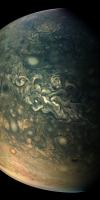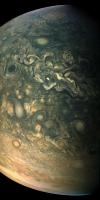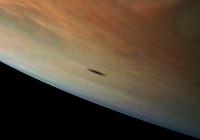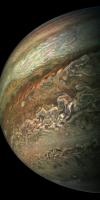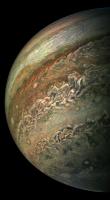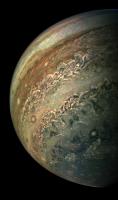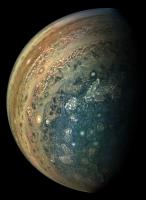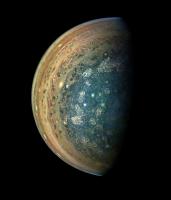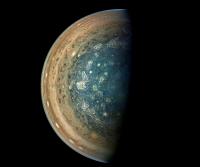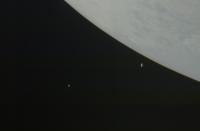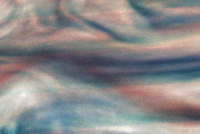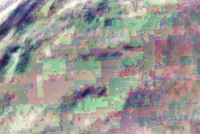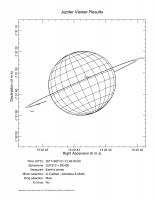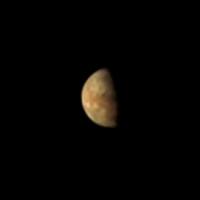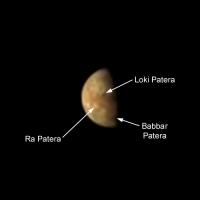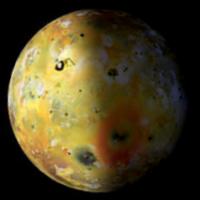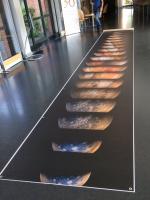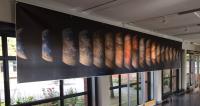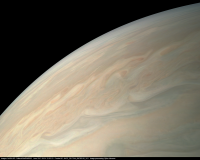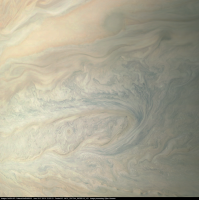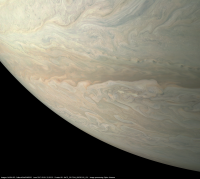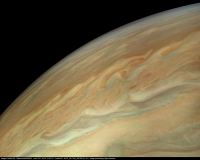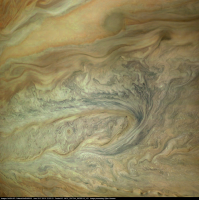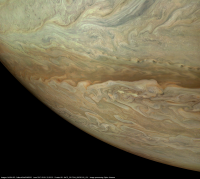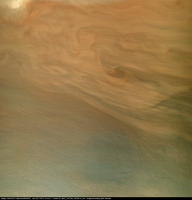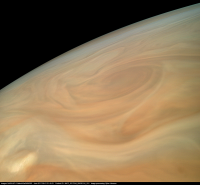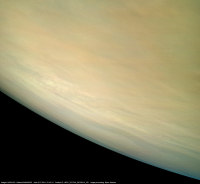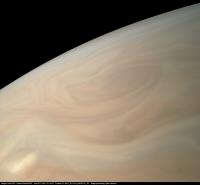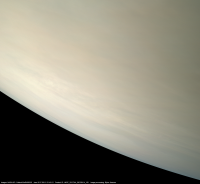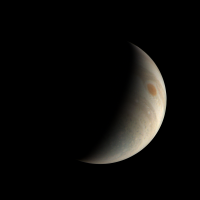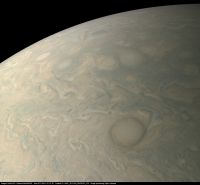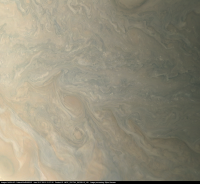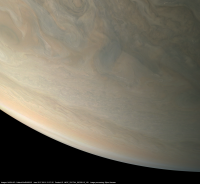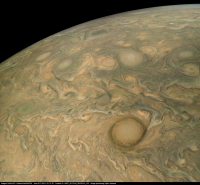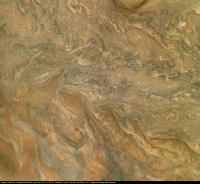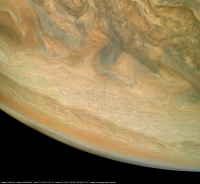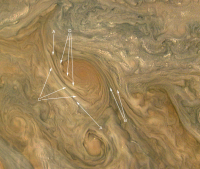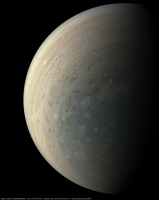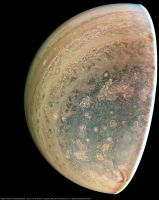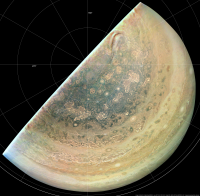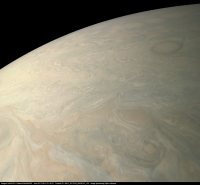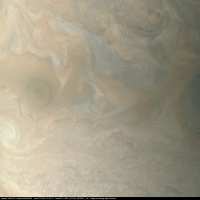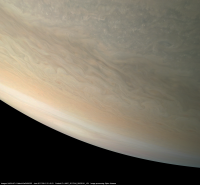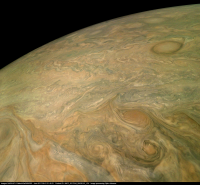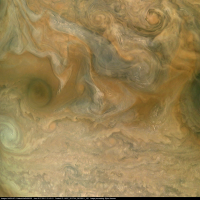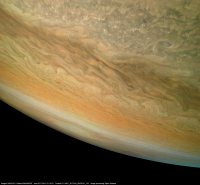Printable Version of Topic
Click here to view this topic in its original format
Unmanned Spaceflight.com _ Juno _ Juno perijove 8
Posted by: Gerald Aug 21 2017, 09:13 PM
It's time to open a Perijove-8 thread. Only a little more than two days are left https://www.missionjuno.swri.edu/junocam/voting?current. For this perijove pass, JunoCam is scheduled to use more memory than during any previous perijove pass. Therefore, we have the best conditions to collect a considerable number of images, and images of good quality.
One of my votes went to an image near the equator, in order to give the ops team the opportunity to take a lossless image from very close up. In previous perijoves, these very close ups suffered a bit from lossy compression. This time, we may have one of the rare chances to find out, whether subtle small features are present, but escaped notice due to high compression rates.
My other votes are for the subpolar regions with the fascinating FFRs.
But I don't make specific recommendations, since I'm hoping for a full latitude coverage in good quality. Besides their science value, such a sequence will be a good basis for a pole to pole animation.
I'm also curious, whether we can learn more about the polar regions. These images are scheduled in any case.
Besides low TDI images, I'm hoping for some high TDI images in order to get high S/N for the circumpolar storm systems.
For Perijove-8, we'll get approach and departure images for a global map. So close to solar conjunction, those are of more interest than in times with good observational conditions from Earth. Unfortunately, during Perijove-9, obtaining a global map will be much harder, if possible at all.
And as a special bonus, an image if Io is scheduled for PJ-08.
My time for processing these images is very restricted in September. But I'll try to cover the full suite of close-ups as soon as the raws become available, nevertheless.
Posted by: PhilipTerryGraham Aug 24 2017, 02:19 AM
Curious question: when they say that this is the "last vote", does it mean what I think it means? ![]()
Posted by: nprev Aug 24 2017, 02:24 AM
I didn't see anything about a last vote. I did see this:
Juno's orbit around Jupiter is evolving. This is the last full opportunity to image Jupiter from 5 days out to 5 days after perijove. We will want to take advantage of this last chance for continuity at every latitude.
Pretty sure that they wouldn't announce EOM like that anyhow. ![]()
Posted by: PhilipTerryGraham Aug 24 2017, 10:14 AM
It's the main subtitle under the link to the Perijove 8 vote on the voting subpage. Hard to miss. I'm incredibly puzzled as to what they mean by this.
Posted by: Bjorn Jonsson Aug 24 2017, 02:25 PM
This may have something to do with the fact that the JunoCam specs call for it to survive only the first eight orbits. Everything beyond that is a bonus.
Posted by: Candy Hansen Aug 24 2017, 05:13 PM
Sorry for the confusion! This will be the last time we select Points of Interest to image based on a public vote. In the near term (PJ9 and PJ10) it is because Jupiter is too close to the sun for earth-based observers to see it, and we won't be able to acquire a marble movie because of the orientation of Juno's orbit. After PJ10 the orbit has moved around such that the geometry will be less intuitive and thus voting would be more complicated. At this moment we are discussing how to replace voting with something else. But we will continue imaging!!
Posted by: tedstryk Aug 25 2017, 12:55 AM
Will there be any distant moon encounters in upcoming orbits? I remember your earlier piece about that, but it was based on the planned orbit.
Posted by: Gerald Aug 25 2017, 12:28 PM
For the small team, there is currently a very high work load with preparing the command sequence for PJ-08, defining a possible extension for the missionjuno website, and preparing talks for EPSC2017. During PJ-08, Io will be imaged.
I guess, that next week, someone might have time to look up distant moon encounters during future orbits.
Posted by: mcaplinger Aug 25 2017, 02:46 PM
There's a distant moon encounter on every orbit, for suitable definition of "distant". Or were you talking about the outer non-galilean moons?
A quick non-official survey to early 2021 shows closest approaches of 172K km to Io, 146K to Europa, 109K to Ganymede, and 678K to Callisto. None of these are close enough to be especially wonderful IMHO.
Posted by: mcaplinger Aug 25 2017, 04:12 PM
To expand on this a little, remember that Juno is solar-powered and so its solar panels must always face the sun (approximately), and Junocam is pointed 90 degrees away from the sun line. In the original mission plan, the orbit was roughly over the terminator over the entire course of the mission, so Junocam was pointed at the planet for part of every spin. Now that the mission is going to last so much longer, Jupiter moves around the sun much more, and the orbit (which is fixed in inertial space, more or less) drifts away from the terminator. If you consider the case when the orbit is 90 degrees from the terminator, Junocam never sees the planet at all for much of a perijove pass.
All of this is complicated by the slightly different orientations that are used (Earth-pointing, normal to the orbit plane, etc.) And Juno can go off-sun and run on batteries for a while, and this will likely be done for some orbits. But all of these scenarios are much more complex than what the public targeting software was designed to handle, so we are still evaluating what we can do within the constraints. Only partly in jest, I suggested at one point that we let the public figure out what might be visible from the available SPICE kernels and then let them vote on that.
Posted by: nprev Aug 26 2017, 10:19 AM
Sounds like a challenge that several people here might be interested in. Any takers?
Posted by: Jackbauer Sep 4 2017, 09:31 PM
first image :
https://www.missionjuno.swri.edu/junocam/processing
Posted by: Gerald Sep 5 2017, 06:46 AM
http://junocam.pictures/gerald/uploads/20170905/. This version is without trajectory nor shape model, but I did some preliminary calibration for the start of the approach sequence.
Posted by: Sean Sep 5 2017, 10:05 AM
Here is a quick process of Gerald's first pass at the data.
https://flic.kr/p/XanzN9
https://flic.kr/p/YdGMnV
*update*
https://flic.kr/p/Y9AJrW
This looks like a particularly beautiful sequence and I can't wait to see everyone's work.
Posted by: climber Sep 5 2017, 12:31 PM
Just beautiful !
Can't wait to watch whether we've got to see Io this time.
Posted by: Gerald Sep 5 2017, 01:41 PM
Perijove 08, images #105, #107, and #108:
Those are JPG versions of the files I uploaded the last almost two hours to missionjuno.
Before this, I spent some time to http://junocam.pictures/gerald/uploads/20170905a/.
Those are the full, uncropped images, for those who can't wait the next few minutes, until I'll have uploaded the other images to UMSF.
I don't even try to describe in words, how fantastic theses images are.
Two of them are preliminary, since they aren't completely free of repetitive camera artifacts; the rather conservative patching algorithm didn't find sufficiently redundant data to patch the spots; at some point later, I may extend the patching algorithm for these rare cases.
Posted by: Gerald Sep 5 2017, 01:49 PM
#113, with some remaining repetitive artifacts, I'll need to work on:
This dark ellipse isn't a processing artifact, but the shadow of a moon:
I didn't find out the shadow of which moon. With the "Eyes on Juno" simulation, I ruled out all four Galileans. There are three possible explanations:
1. I made a mistake by using the simulation.
2. The simulation is inaccurate.
3. It's the shadow of Amalthea.
Is there anyone here, who is able to find out, which moon cast the shadow?
Posted by: Sean Sep 5 2017, 02:11 PM
Wow Gerald...just fantastic. I'm rolling up my sleeves...
Isn't that artifact a moon shadow? Looks like it!
*update*
You figured it out! ![]()
Posted by: Johann Guillon Sep 5 2017, 08:14 PM
Hi everybody,
here's my contribution for this flyby.
To little guys salute us.
Awesome job Gerald, as always. Thank you !
Posted by: mcaplinger Sep 6 2017, 01:00 AM
BTW, note that image 114 ("Collision of colours"/"Sharp edge") was taken in lossless compression mode; several people had asked if images near PJ were being degraded by lossy compression. I'd be curious to hear if people thought it made a significant difference.
Posted by: Gabriel Sep 6 2017, 02:58 AM
I’m astonished by your work gerald, here is a quick edit I made earlier tonight. Enjoy!
https://goo.gl/tYPRTD
Posted by: stevesliva Sep 6 2017, 03:25 AM
These colors seem... right. Familiar? nicely done.
Posted by: Gerald Sep 6 2017, 12:56 PM
I'm among these people, and this is why:
Both processed in a similar way, hipassed and stretched linearly.
Some scientifically interesting features are about the same size as the DCT artifacts.
But I'm aware of the limited storage. So, we need to make a decision between coverage and subtle detail.
@Gabriel: Wonderful!
And also Johann Guillon: I'm learning, that there is always space for improvements. With each round we are going to be a little better.
Posted by: Sean Sep 6 2017, 03:28 PM
Here is a 19 frame PJ08 sequence based on Gerald's source...
11 Megapixel
https://flic.kr/p/Ydhso1
https://flic.kr/p/XSjqUy
https://flic.kr/p/YbHZUy
https://flic.kr/p/YbJda5
Posted by: JRehling Sep 6 2017, 03:50 PM
What this helped me realize is that the programs I use to generate moon location predictions do not include Amalthea. The big ~7 of Saturn and big 5 of Uranus are pretty standard, but the Jupiter ephemeris programs I use all include the Galileans and nothing else. But I found this one:
https://pds-rings.seti.org
And here is the simulated view during the last Juno encounter.
Amalthea is dead center. It's the culprit. Also, the smaller moons would not cover the Sun as seen from Jupiter, and therefore wouldn't generate an umbra, only a penumbra. Amalthea doesn't cover it completely, either. The day after the eclipse, someone asked me if there are any other cases of moons that just cover the Sun as seen from their planet, and there are some close candidates, Callisto being the closest, but none (known) so close as the Moon seen from Earth.
This also helped me realize that Thebe is pretty big – almost half the size of Amalthea. Metis and Adrastea are much smaller.
Posted by: Johann Guillon Sep 6 2017, 04:33 PM
I try to make what I saw through my telescope. Maybe little bit more sharp and detailed
Thank you !
Posted by: Sean Sep 7 2017, 02:01 PM
Updated process with Gerald's source... PJ08_121
https://flic.kr/p/Ydmk4h
(repaired the cropped limb)
*update*
8k version
https://flic.kr/p/XevpM7
Posted by: tedstryk Sep 7 2017, 08:47 PM
Can't wait to watch whether we've got to see Io this time.
Yes, we got a nice peek at Io.
Posted by: jasedm Sep 7 2017, 09:03 PM
Absolutely wonderful. These images from Jupiter are simply astonishing.
Posted by: Sean Sep 7 2017, 09:15 PM
Thankee.
Here is a portrait of PJ08_124 using Gerald's source...
https://flic.kr/p/XeLBW7
Upscaled to 36 Megapixel & processed.
Here is a processed detail from PJ08_110...
https://flic.kr/p/XUyLmQ
Posted by: JRehling Sep 8 2017, 12:00 AM
I don't know when we got conclusive evidence that we are seeing relief in the cloud shadows, but we definitely have by now. Little storm heads all over the place.
Posted by: Phil Stooke Sep 8 2017, 04:19 PM
Great pictures everyone!
I can't be absolutely certain yet, but I think these are the features we are seeing in the Io image:
(strictly speaking we are seeing large albedo features around those paterae, not the paterae themselves)
Large changes in surface features might be detectable if this is compared with older images.
Phil
Posted by: Phil Stooke Sep 8 2017, 04:31 PM
Here's an image to compare with the Juno view, almost the correct orientation. It's rendered, not an original image.
Phil
Posted by: Sean Sep 8 2017, 06:50 PM
Here is a detail from Gerald's PJ08_118...
https://flic.kr/p/Yj6ycF
Upscaled, stretched, processed, edges filled.
Posted by: Sean Sep 9 2017, 07:46 PM
Here is a portrait from Gerald's PJ08_108...
https://flic.kr/p/Xi1mdN
Upscaled & processed.
Posted by: Gerald Sep 12 2017, 05:30 AM
https://www.youtube.com/watch?v=sb8WvC0kDqI.
http://junocam.pictures/gerald/uploads/20170912/.
Actually, except the first and the last scene, I've rendered each scene twice, based on two consecutive raws.
The stills are JPG, but should be in good quality. PNG would have been too large, regarding upload time and volume.
Note, that the stills of consecutive scenes overlap by one still. In order to obtain a seamless movie, skip the first frame of each scene, except the first scene. However, for frame interpolation you might need the first respective still of each scene.
Posted by: Sean Sep 12 2017, 09:29 AM
Thanks for sharing these Gerald, there is so much to see in this perijove pass! You've done a grand job blending the different images together also. For me, the only 'issue' is the snapping of the camera path, although this is much less problematic now that the images have smooth blending.
Posted by: Sean Sep 15 2017, 05:51 PM
I shared Gerald's PJ08 sequence over on Twitter and the 150dpi 11m x 2m image was actually printed out to 8.5m x 1.3m fabric!
https://twitter.com/_TheSeaning/status/905541216468652033
Posted by: Sean Sep 16 2017, 09:59 PM
Here are some upscaled, processed & retimed clips from Gerald's PJ08 animation. They are still works in progress but they do feature a new re-timing method which reduces the appearance of the stepping issue when the animation switches between projected textures. The nested clips are 3 levels deep and the motion vector calculation never has to synthesize more than one frame each time. The previous solution was not nested and the software had to guess up to 10 frames which gave rise to motion artifacts.
https://flic.kr/p/YupW7S
This clip features the transition between PJ08 121 & 122
https://flic.kr/p/Xvedz3
PJ08 108 - 109
https://flic.kr/p/Xxoddb
Posted by: stevesliva Sep 18 2017, 01:57 PM
https://twitter.com/_TheSeaning/status/905541216468652033
Awesome... so where is it hanging?
Posted by: Sean Sep 18 2017, 05:49 PM
It's hanging in Lund, Sweden.
Posted by: Bjorn Jonsson Sep 18 2017, 10:42 PM
After making a few improvements to my Juno-related software I now at last have some processed PJ8 stuff. This is from the PJ8_118 data, first approximately true color/contrast versions:
And the enhanced versions:
A subset of the relevant metadata:
IMAGE_TIME = 2017-09-01T22:03:23.474
MISSION_PHASE_NAME = PERIJOVE 8
PRODUCT_ID = JNCE_2017244_08C00118_V01
SPACECRAFT_ALTITUDE = 12143.0 km
SPACECRAFT_NAME = JUNO
SUB_SPACECRAFT_LATITUDE = -28.5406
SUB_SPACECRAFT_LONGITUDE = 329.8497
TITLE = POI's: Dalmatian Zone, Eye of Odin
Resolution at nadir: ~8.2 km/pixel
Posted by: Sean Sep 20 2017, 10:07 AM
Beautiful work Bjorn.
Here is a montage of Gerald's perijove 08 clips set to Brahms
https://flic.kr/p/YTNR6K
Posted by: Bjorn Jonsson Sep 22 2017, 10:59 PM
Yes, this makes a significant difference in low contrast areas. Here is a heavily processed image showing the area near the nadir in PJ8_114:
I was able to apply a more severe contrast stretch and unsharp mask than I usually do - and without having to worry about compression artifacts. This is a good thing because this is a lower contrast image than most of the Juno images. In a 'normally' compressed image the low contrast regions would have a 'contoured' appearance and/or squares of uniform (or near uniform) brightness and color would be obvious (Gerald posted an example earlier). The lower part of the image is more heavily processed than the upper part since the contrast there is lower in the original data. The difference from ICT compressed images is visually biggest in the blue channel - it is darker than R/G and frequently looks rather uniform or even noisy in ICT compressed images (it has even occurred to me to try to generate synthetic blue images by combining low frequency brightness variations from the blue channel with high frequency information from the green channel).
Would it be possible to generate a version of the raw image showing what it would have looked like with typical lossy compression parameters? If this is possible I would be interested in applying the same processing to that version of the image as I did in the image above.
By the way I have noticed one minor issue with all of the very high resolution images I have processed (I haven't processed many of these though). Here is an example:
There are very narrow gaps between the framelets. This only occurs near the nadir and only in the red channel. I don't think this is an error in my processing. It's easy to fill these gaps and they are very narrow so I consider this a minor issue.
Posted by: Bjorn Jonsson Sep 22 2017, 11:16 PM
And here are two more images processed from PJ8_114. They show the northern and southern limb:
I processed these images more heavily than I usually do, both because of the low contrast in most of the areas covered by PJ8_114 and also because of the lossless compression. The image at left is especially interesting and appears to show long, narrow and elevated clouds plus associated cloud shadows and vertical relief near the horizon.
And here are approximately true color/contrast versions of all three images. The last one isn't exactly impressive and reminds me of Saturn because of the low contrast. I suspect the generally low contrast and fuzziness of these images is mainly because the contrast really is lower here than it is farther from the equator; if this is correct the very high resolution (~2.3 km/pixel at the nadir) is not the main reason for the low contrast.
And the associated metadata:
IMAGE_TIME = 2017-09-01T21:49:21.459
MISSION_PHASE_NAME = PERIJOVE 8
PRODUCT_ID = JNCE_2017244_08C00114_V01
SPACECRAFT_ALTITUDE = 3472.2 km
SPACECRAFT_NAME = JUNO
SUB_SPACECRAFT_LATITUDE = 10.1385
SUB_SPACECRAFT_LONGITUDE = 319.5073
TITLE = POI's: Collision of colours, Sharp edge
Resolution at nadir: ~2.3 km/pixel
Posted by: MahFL Sep 23 2017, 01:32 AM
That's pretty cool.
Posted by: Bjorn Jonsson Sep 23 2017, 10:17 PM
Here is an image from the departure sequence:
This is the best view of the Great Red Spot from the departure sequence. I processed it mainly as a 'sanity check' to confirm that my color processing (still) results in global color that looks about right.
This is image PJ8_161 from the departure sequence. North is up. The image was obtained on 2017-09-02 07:30:25.957 when Juno was about 800,000 km from Jupiter's center.
Posted by: scalbers Sep 24 2017, 12:00 AM
Nice to see these realistically processed views. One fine point is that with such high resolution we might be able to resolve a region along the limb where a high clear portion of the atmosphere would produce a thin blue layer due to Rayleigh scattering. Is the limb fully shown in these images?
Posted by: Bjorn Jonsson Oct 1 2017, 12:43 PM
The limb is not fully shown. The images are processed by creating a simple cylindrical map and then using the map to render an image. This 'truncates' the limb near the 1 bar level. That said, I suspect the resolution at the limb isn't higher in the JunoCam images than in many of the Voyager images since the resolution at the limb is much lower than at the nadir (I haven't computed the exact resolution at the limb though).
I have experimented a bit with creating JunoCam color composites showing the limb but the results aren't very interesting. The best processed Voyager image I know of showing the limb is http://www.unmannedspaceflight.com/index.php?showtopic=6705&view=findpost&p=232103 and there is also http://www.unmannedspaceflight.com/index.php?showtopic=6705&view=findpost&p=232145. These are also probably the highest resolution color images showing blue sky at the limb that can be processed from the Voyager 1 and Voyager 2 data.
Posted by: Bjorn Jonsson Oct 6 2017, 07:51 PM
Image PJ8_110, approximately true color/contrast:
And with enhanced color and contrast. The effects of the solar illumination have been removed:
Lots of cloud shadows are visible, especially in the 'central' image (the one where Jupiter's limb isn't visible). Possible vertical relief can also be seen at various locations.
And the relevant metadata:
IMAGE_TIME = 2017-09-01T21:37:50.343
MISSION_PHASE_NAME = PERIJOVE 8
PRODUCT_ID = JNCE_2017244_08C00110_V01
SPACECRAFT_ALTITUDE = 9838.0
SPACECRAFT_NAME = JUNO
SUB_SPACECRAFT_LATITUDE = 41.77
SUB_SPACECRAFT_LONGITUDE = 310.6919
TITLE = POI: AB Territory
Resolution at nadir: ~6.6 km/pixel
Posted by: Bjorn Jonsson Oct 7 2017, 08:28 PM
The central image in the above post has some of the best examples of direct imaging of (probable) cloud elevation differences that I have seen in images of Jupiter. Here is an enlarged crop from the image with some annotations:
The sun illuminates the clouds from the west (left) in this image. Keeping this in mind it's looking very much like we are seeing 'topography' at various locations, in particular around the vortex left of center:
A: Clearly defined 'valleys'.
B: More subtle 'valleys' than in A.
C: Elevated and elongated high altitude 'walls' of clouds that are apparently roughly parallel to the wind direction around the vortex.
D: Elevated clouds that have a more irregular shape than the clouds in C.
There are also some some subtle indications that narrower and subtle 'valleys' and 'ridges' may spiral into the vortex toward its center.
It is possible that these features are due to clouds of different color/brightness and not due to altitude differences. However, looking at the image, altitude differences look to me like the obvious (and more likely) explanation.
Posted by: Bjorn Jonsson Oct 16 2017, 09:52 PM
Image PJ8_124, true color/contrast version and an enhanced version:
In the enhanced version the effects of global illumination have been removed. This reveals various details in the dimly lit areas near the terminator and near the south pole.
And an orthographic view showing the south pole:
A latitude/longitude grid is included. This reveals the location of Jupiter's south pole. It's remarkable how different Jupiter's polar areas are from Saturn's. They look much more irregular and chaotic, the belt/zone structure breaks down and in particular there is no vortex centered on Jupiter's pole as in Saturn's case.
Another interesting feature is the relatively narrow, curved band of haze (?) not far from the pole.
A subset of the metadata associated with the original data:
IMAGE_TIME = 2017-09-01T22:34:02.788
MISSION_PHASE_NAME = PERIJOVE 8
PRODUCT_ID = JNCE_2017244_08C00124_V01
SPACECRAFT_ALTITUDE = 60546.9 km
SPACECRAFT_NAME = JUNO
SUB_SPACECRAFT_LATITUDE = -71.5392
SUB_SPACECRAFT_LONGITUDE = 355.0833
TITLE = POI: South Polar region
Resolution at nadir: ~40 km/pixel
Posted by: Gerald Oct 18 2017, 06:20 PM
John Rogers (BAA) posted his https://britastro.org/node/11489.
Note, that global maps will be increasingly difficult to obtain for the next perijoves, and likely impossible at some point.
Posted by: elakdawalla Oct 19 2017, 03:15 AM
Jupiter's south pole is a "vortex crystal" with a stable pentagonal arrangement of cyclones: https://twitter.com/jtuttlekeane/status/920409321246199814
Work by Fachreddin Tabataba-Vakili. You can see part of the pentagon clearly in Bjorn's polar projection.
Posted by: Gerald Oct 19 2017, 09:43 AM
I doubt, that these things are cleared for public release as of yet.
Posted by: mcaplinger Oct 19 2017, 02:44 PM
If you don't want to release something, then don't stand up at a public conference and present it.
There's a DPS abstract online for this, although it has some coy language: "These observations reveal a turbulent environment with an unexpected structure of cyclonic polar vortices."
Posted by: Gerald Oct 19 2017, 03:57 PM
After some more investigation, I think, that we are on the safe side of the grey area, as long as we don't comment publicly on the contents of the tweets.
Posted by: mcaplinger Oct 19 2017, 04:04 PM
You mean "you are". My name's not on the abstract.
Posted by: Gerald Oct 19 2017, 04:16 PM
You are in Candy's team. Without your camera neither Candy's nor my name would be on the abstract, if it could have been written at all.
Posted by: Bjorn Jonsson Oct 23 2017, 11:18 PM
Yet another collection of images, this is from PJ8_111 (approximately true color/contrast):
And a version with enhanced contrast and color. The effects of global illumination have been removed:
The subspacecraft latitude is ~36 degrees north. Areas around this latitude are particularly photogenic in the JunoCam imagery with lots of cloud shadows, small vortices, various colors, vertical relief etc. For example, there are also http://www.unmannedspaceflight.com/index.php?showtopic=8302&view=findpost&p=235957 where the subpscecraft latitude is similar (there are several more versions processed from this particular data set in the PJ6 thread).
Finally a subset of the metadata:
IMAGE_TIME = 2017-09-01T21:40:20.749
MISSION_PHASE_NAME = PERIJOVE 8
PRODUCT_ID = JNCE_2017244_08C00111_V01
SPACECRAFT_ALTITUDE = 7545.3 km
SPACECRAFT_NAME = JUNO
SUB_SPACECRAFT_LATITUDE = 35.6148
SUB_SPACECRAFT_LONGITUDE = 312.671
TITLE = POI: Turbulent sector of the NNTB
Resolution at nadir: ~5.1 km/pixel
Posted by: Brian Swift Nov 5 2017, 09:15 PM
My PJ08 approach movie. https://youtu.be/LlbUNUHBgec Has a number of shadows (or maybe sensor artifacts, I haven't investigated yet).
PJ08 departure movie. https://youtu.be/OeuWreXKj_o
Coloration along edges due to imperfections in my camera model.
Posted by: Sean Dec 18 2017, 05:15 AM
PJ08_108 update [G.Eichstadt]
Detail
https://flic.kr/p/Etin2N
Posted by: Sean Dec 27 2017, 04:43 PM
Update to PJ08_123 [G.Eichstadt]
https://flic.kr/p/21Ak2pn
I've arrived at a new process which means I'll be revisiting some of the older perijove portraits in the coming weeks, time permitting.
Posted by: Sean Mar 8 2018, 02:27 AM
PJ08 latter sequence
https://flic.kr/p/23UexMU
Posted by: Sean Apr 13 2018, 04:47 PM
PJ08_122_new pass
https://flic.kr/p/268m2Ki
Posted by: Sean Apr 16 2018, 12:02 AM
PJ08_121 new process pass details & portrait
https://flic.kr/p/2693Rsy
https://flic.kr/p/2693RjN
https://flic.kr/p/2693REY
Posted by: JRehling Apr 16 2018, 04:02 AM
Check out the little red spot in the upper left of the first of those.
I guess this means the altitude is quite high, meaning a very high pressure and anticyclonic nature to that storm despite its relatively small size.
I'd like to see some estimate isobars mapped onto these images.
Powered by Invision Power Board (http://www.invisionboard.com)
© Invision Power Services (http://www.invisionpower.com)




